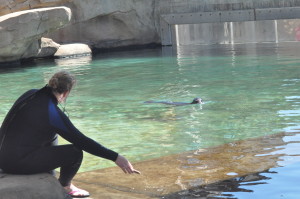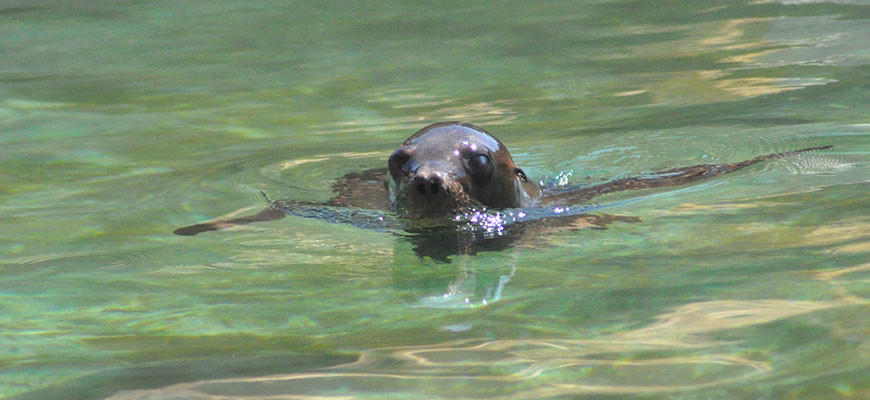They have large puppy-dog eyes, bristling whiskers, smoke-colored fuzz and floppy flippers. “They’re painfully cute,” says Jane Anne Franklin, Mammal Curator and Supervisor of Animal Training. What’s she referring to? Meet Riva and Spike — our new young seal and sea lion that recently arrived at the Louisville Zoo!
Riva (a one-year-old California sea lion) has a fun and free personality. “She is training great and learning rapidly,” says Franklin. Riva “the rocket” loves to swim and zip around. Spike (a two-year-old harbor seal) is more laid-back and shy. Looking at them, you wouldn’t immediately realize that they were recently saved from an “Unusual Mortality Event” happening off the coast of California.
Unusual Mortality Events are defined under the Marine Mammal Protection Act as “a stranding that is unexpected; involves a significant die-off of any marine mammal population; and demands immediate response.”
Spike and Riva are just two of the hundreds of sea lions and seals rescued so far. Between January and May 2015, California sea lion strandings were 10 times higher than the average for the same period during 2004 – 2012. Rehabilitation centers are currently overwhelmed. The sheer number of pups isn’t the only alarming issue: some are in very poor shape, weighing less than half of what they should.
“There was an Unusual Mortality Event last year also,” says Franklin, “but this year it is much worse. Oceans are changing. Fishing is changing. The availability of food and fish in the ocean is changing. Moms aren’t nursing pups as long. Moms can’t find enough food; they’re weaning pups earlier and the young ones are not being taught how to find fish on their own.”
Both of the new Louisville Zoo pinnipeds were found off the California coast stranded, malnourished and dehydrated. “Spike had visible wounds to his right rear flipper,” says Franklin. “He was potentially going to become a food item for some larger shark or orca.” Spike was rehabilitated and put back with a group of youngsters his age and size; however, he showed up stranded again and had some discharge from his left ear. “It was speculated that his eardrum was ruptured and he couldn’t dive deep enough to be able to hunt for fish,” Franklin explains. “He needed to be placed in managed care.”
Riva, on the other hand, was found stranded on Malibu beach. She was also undernourished and dehydrated — and while trying to recover, she sustained an eye injury. Due to the long-term care for her eye injury and her timid-appearing personality, the veterinarian caring for her at the California Wildlife Center requested that National Marine Fisheries Service (NMFS) place her in a managed-care facility as well.
NMFS contacted the Louisville Zoo, on their list for potential care facilities, to let us know that they had some animals needing special care and homes. Franklin assessed the needs of the animals and conferred with our cheif veterinarian Dr. Zoli Gyimesi to see if Louisville would be a good match. “With these two animals, their issues were being treated, but they needed permanent homes,” explained Franklin, and a decision was made to assist with the rescued seal and sea lion.
Franklin and Jill Katka, one of the Zoo’s mammal curators, flew to Los Angeles to retrieve the small pinnipeds. They took a commercial flight out and made arrangements for a return flight with a carrier able to accommodate the animals and their holding crates plus the watchful and attentive keepers. After arriving in Los Angeles and ensuring things were in order, Franklin and Katka headed to the rescue facility to meet Spike and Riva.
Franklin shared that “When we got to the rescue center, there were so many. It was madness. There were all these adorable little sea lions zooming around! The number of sea lions the rescue center has saved already this season is as many as they rescued over the last two years put together.”
Once our new pinnipeds were loaded into their transport crates in a climate-controlled truck, they were shuttled to the airport and boarded a flight to their new home in Glacier Run at your Louisville Zoo. Franklin and Katka flew in jump seats near the animals so that they could closely monitor them during the flight home.
 Keepers are spending extra time and conducting extra training sessions with them as they adjust to their new home. “It’s fun getting them out and into the exhibit pool,” says Franklin. “We’re taking time to get them acclimated — especially Riva. She’s not very big! My favorite part has been seeing their personalities develop, watching people fall in love with them and knowing they’re in a safe place and not going to be shark or orc food. They’re true ambassadors for their species to teach people why we’re here — to entertain but also to educate people at the same time.”
Keepers are spending extra time and conducting extra training sessions with them as they adjust to their new home. “It’s fun getting them out and into the exhibit pool,” says Franklin. “We’re taking time to get them acclimated — especially Riva. She’s not very big! My favorite part has been seeing their personalities develop, watching people fall in love with them and knowing they’re in a safe place and not going to be shark or orc food. They’re true ambassadors for their species to teach people why we’re here — to entertain but also to educate people at the same time.”
California sea lions a sentinel species, meaning they can be indicators of the state of the ocean and its health. Researchers are still unsure at this time what is causing this escalation in stranded animals.
Some scientists suggest climate change may be playing a role. Possible impacts on the ocean environment, such as overfishing and pollution, are not helping the problem. One thing is certain — the ripple effects are being felt along the California coast as starving pups continue to wash ashore. Franklin said, “even though we live in Louisville, Kentucky — we need to be thoughtful about the way we take care of our environment here because it can have an impact globally.” You can learn more about what you can do by visiting nmfs.noaa.gov.
Don’t forget to come meet your new Louisville Zoo pinniped ambassadors. Watch Spike and Riva zoom around, jump on rocks and glide through the water! They’ll be on rotation this fall at Glacier Run. You can also learn lots more about them during our training presentations. Check the animal presentation schedule available at louisvillezoo.org/today.
Post-publication note: Reva is currently on rotation in Glacier Run. See press release, “Louisville Zoo Participates in Rescues.”

